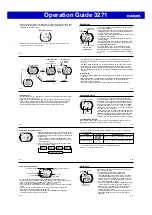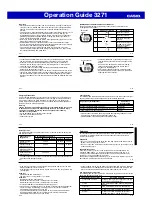
Operation Guide 3271
E-40
Important!
•
Storing the watch for long periods in an area where there is no light or wearing it in
such a way that it is blocked from exposure to light can cause rechargeable battery
power to run down. Be sure that the watch is exposed to bright light whenever
possible.
•
This watch uses a rechargeable battery to store power produced by the solar cell, so
regular battery replacement is not required. However, after very long use, the
rechargeable battery may lose its ability to achieve a full charge. If you experience
problems getting the rechargeable battery to charge fully, contact your dealer or
CASIO distributor about having it replaced.
•
Never try to remove or replace the watch’s rechargeable battery yourself. Use of the
wrong type of battery can damage the watch.
•
All data stored in memory is deleted, and the current time and all other settings
return to their initial factory defaults whenever battery power drops to Level 5 (pages
E-41 and E-42) and when you have the battery replaced.
•
Turn on the watch’s Power Saving function (page E-51) and keep it in an area
normally exposed to bright light when storing it for long periods. This helps to keep
the rechargeable battery from going dead.
E-41
Level
1
2
3
4
5
Battery Power Indicator
Function Status
All functions enabled.
All functions enabled.
Illumination, and beeper
disabled.
Except for timekeeping and
the
CHG
(charge) indicator,
all functions and display
indicators disabled.
All functions disabled.
Battery Power Indicator and Recover Indicator
The battery power indicator on the display shows you the current status of the
rechargeable battery’s power.
Battery power
indicator
ll ll
ll
ll
ll
ll
l l l
E-42
•
The flashing
L
and
LOW
indicators at level 3 tell you that battery power is very low,
and that exposure to bright light for charging is required as soon as possible.
•
At Level 5, all functions are disabled and settings return to their initial factory
defaults. Once the battery reaches Level 2 after falling to Level 5, reconfigure the
current time, date, and other settings.
•
The watch’s Home City code setting will change automatically to
TYO
(Tokyo)
whenever the battery drops to Level 5.
•
Display indicators reappear as soon as the battery is charged from Level 5 to Level 2.
•
Leaving the watch exposed to direct sunlight or some other very strong light source
can cause the battery power indicator to show a reading temporarily that is higher
than the actual battery level. The correct battery level should be indicated after a few
minutes.
E-43
•
Performing illumination, or beeper operations during a
short period may cause
(recover) to appear on the
display.
After some time, battery power will recover and
(recover) will disappear, indicating that the above
functions are enabled again.
•
If
(recover) appears frequently, it probably means
that remaining battery power is low. Leave the watch in
bright light to allow it to charge.
Recover indicator
E-44
Charging Precautions
Certain charging conditions can cause the watch to become very hot. Avoid leaving
the watch in the areas described below whenever charging its rechargeable battery.
Also note that allowing the watch to become very hot can cause its liquid crystal
display to black out. The appearance of the LCD should become normal again when
the watch returns to a lower temperature.
Warning!
Leaving the watch in bright light to charge its rechargeable battery can cause it
to become quite hot. Take care when handling the watch to avoid burn injury.
The watch can become particularly hot when exposed to the following
conditions for long periods.
•
On the dashboard of a car parked in direct sunlight
•
Too close to an incandescent lamp
•
Under direct sunlight
E-45
Exposure Level (Brightness)
Outdoor Sunlight (50,000 lux)
Sunlight Through a Window (10,000 lux)
Daylight Through a Window on a Cloudy Day (5,000 lux)
Indoor Fluorescent Lighting (500 lux)
Approximate
Exposure Time
5 minutes
24 minutes
48 minutes
8 hours
Charging Guide
The following table shows the amount of time the watch needs to be exposed to light
each day in order to generate enough power for normal daily operations.
•
For details about the battery operating time and daily operating conditions, see the
“Power Supply” section of the Specifications (page E-56).
•
Stable operation is promoted by frequent exposure to light.
E-46
Recovery Times
The table below shows the amount exposure that is required to take the battery from
one level to the next.
Approximate Exposure Time
Level 5
Level 4
Level 3
Level 2
Level 1
3 hours
23 hours
7 hours
9 hours
115 hours
31 hours
17 hours
234 hours
63 hours
202 hours
- - - - - - - -
- - - - - - - -
Exposure Level
(Brightness)
Outdoor Sunlight
(50,000 lux)
Sunlight Through a
Window (10,000 lux)
Daylight Through a
Window on a Cloudy
Day (5,000 lux)
Indoor Fluorescent
Lighting (500 lux)
•
The above exposure time values are all for reference only. Actual required exposure
times depend on lighting conditions.
▲
▲
▲
E-47
Reference
This section contains more detailed and technical information about watch operation.
It also contains important precautions and notes about the various features and
functions of this watch.
Stopwatch
•
You can use lap time measurement to time how long it takes to complete a specific
portion (such as a single lap) of a race.
•
You can use split time measurement to time how long it takes to get from the start to
a specific point in a race.
Memory Management
Each time you press
D
to start a new elapsed time or lap/split operation in the
Stopwatch Mode (page E-17), the watch automatically creates a new “log” in its
memory. The log remains open for data storage until you permanently close it by
pressing
B
to clear the stopwatch to all zeros.
The watch has enough memory to hold up to 121 records. Each log title screen (start
date and time) and lap/split time uses up one record.
E-48
•
A log title screen identifies a single elapsed time operation, from the start up to the
point the stopwatch is reset to all zeros.
•
A lap/split time record is stored under a log title screen each time you perform a lap/
split operation.
Example 1
Single elapsed time measurement
Log title 120 lap records = 121 records
Example 2
Multiple elapsed time measurements
Measurement 1 log title 60 lap records = 61 records
Measurement 2 log title 59 lap records = 60 records
•
Use the Recall Mode to view stopwatch records (page E-21).
•
If watch memory is already full when you perform a stopwatch button operation that
creates a new log, the oldest log in memory and all of its records are deleted
automatically to make room for the new log.
•
If you are adding records to the only log in memory and watch memory becomes
full, adding another record causes the oldest record in the log to be deleted
automatically to make room for the new record.
E-49
•
If you are adding records to a log when there are multiple logs in memory and watch
memory becomes full, adding another record causes the oldest log in memory and
all of its records to be deleted automatically to make room for new records.
How Stopwatch Data is Stored
The following table describes how data is stored when you perform the various button
operations described on page E-18.
Stopwatch Button Operation
D
Start (from all zeros)
D
Stop
D
Re-start
B
Lap/Split
B
Clear
Data Store Operation
Creates a new log for the current date. (The log
is updated as timing progresses.)
Time measurement stops, without storing data in
memory.
Time measurement re-starts, without storing
data in memory.
Creates new record: displayed lap/split times
Creates new record: displayed lap/split times
(Stopwatch display is cleared to all zeros.)
























